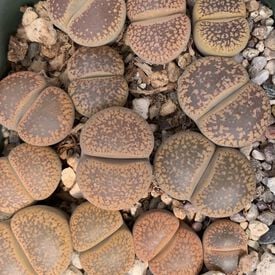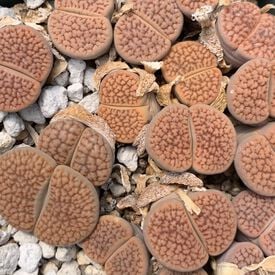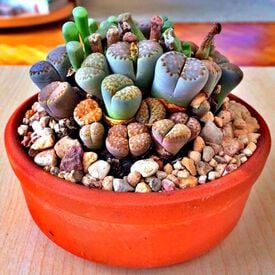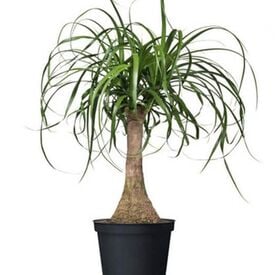Living stone plants (Lithops species) are native to South Africa, where they grow among rocks. Aucampiae lithops are succulents with brown skin tones. Living stones are small plants, often only 1/2" to 1" in diameter. Very little water is needed and oo much water can kill the plants. Yellow or white flowers appear towards the end of the growing season. Generally grown as houseplants. Seed Germination: Sprinkle lithops seeds over the surface and cover with a fine layer of sand or vermiculite. Keep lightly moist. Germination should occur within 4-10 days.
Living stone plants (Lithops species) are native to South Africa, where they grow among rocks. Hookerii lithops are succulents with red-brown skin tones and brain looking wrinkles. Living stones are small plants, often only 1/2" to 1" in diameter. Very little water is needed and oo much water can kill the plants. Yellow or white flowers appear towards the end of the growing season. Generally grown as houseplants. Seed Germination: Sprinkle lithops seeds over the surface and cover with a fine layer of sand or vermiculite. Keep lightly moist. Germination should occur within 4-10 days.
Living stone plants (Lithops species) are native to South Africa, where they grow among rocks. Fulviceps lithops are succulents with green skin tones. Living stones are small plants, often only 1/2" to 1" in diameter. Very little water is needed and oo much water can kill the plants. Yellow or white flowers appear towards the end of the growing season. Generally grown as houseplants. Seed Germination: Sprinkle lithops seeds over the surface and cover with a fine layer of sand or vermiculite. Keep lightly moist. Germination should occur within 4-10 days.
Living stone plants (Lithops species) are native to South Africa, where they grow among rocks. Mixed lithops are succulents with green, blue and red-brown skin tones. Living stones are small plants, often only 1/2" to 1" in diameter. Very little water is needed and oo much water can kill the plants. Yellow or white flowers appear towards the end of the growing season. Generally grown as houseplants. Seed Germination: Sprinkle lithops seeds over the surface and cover with a fine layer of sand or vermiculite. Keep lightly moist. Germination should occur within 4-10 days.
Kalanchoe thyrsiflora is a great succulant that forms a basal rosette of large rounded, fleshy leaves, which are grayish cream with red margins. Plants are erect, upward-facing and are tightly arranged leaves. A beautiful indoor plant that does well in most conditions. Seed Germination: Moisten soil in a container and surface sow the seeds. Do not cover the seeds. They need sunlight to germinate. Put the container in a plastic bag to create a humid environment for the seeds. Germination should occur within 10 days.
Madagascar palm (Pachypodium lamerei) is a stunning succulent with a single, shiny silver, thorny trunk. It is topped with long, slender showy green leaves with a prominent white leaf vein. This plant is tolerant to a wide range of growing conditions and well-resistant to pests and diseases. As a houseplant P. lamerei stays less tall, but it can still grow dramatically over time. In its trunk it stores water, making it a highly water-wise / drought-resistant plant. Seed Germination: Soak seeds for 12 hours before planting. Plant at least 4-5 seeds per pot. Bottom heat is helpful. Takes 4-14 days to germinate.
Ponytail aka, Beaucarnea recurvata or Nolina recurvata, often gets mistaken for a palm, but actually is a semi-succulent. This unique looking tree-like perennial has a large swollen trunk, which stores water. The dark green leaves are long and thin and emerge from the trunk like a fountain. Ponytail is a well-known robust, sun-loving houseplant. In mild to warmer climates it can be used as a waterwise patio plant or for landscaping. Also know as Bottle palm or Elephant's foot. Seed Germination: These seeds inherently have a low germination rate. They should also be soaked in a wet paper towel 7-21 days until they germinate. Check on seeds daily. Once germinated transfer to your seed starting soil.







